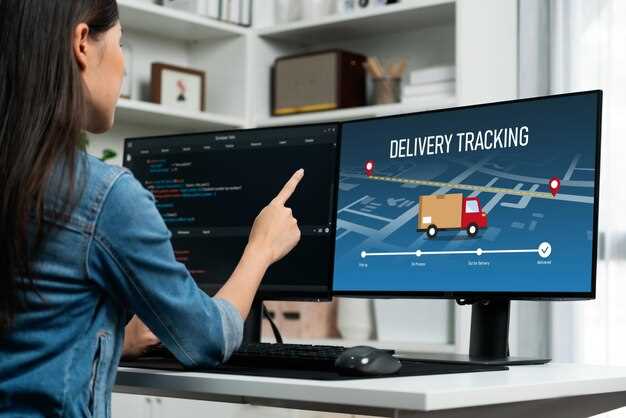Begin with three steps: map orders, pickups, and deliveries, then automate routing across all areas to achieve rapid cycle improvements.
Apply a personalized carrier plan that matches zones to service levels. This framework can empower field teams with mobile dashboards and enable on-the-fly decisions. Use driverless last-mile pilots as a catalyst for on-time deliveries.
For enterprises with expansive networks, consolidating shipments yields measurable gains: deliveries per route increase by 15–25%, while total miles driven drop by 7–12%, and handling steps drop by a third when routing is optimized with real-time load data. Establishing clear KPIs such as on-time rate, average transit time, and cost per parcel helps maintain momentum.
Выберите carriers with on-time rates above 95% and integrate routing with your WMS/ERP to minimize touches. Focus on rapid changes in daily plan, and establish daily dashboards that constantly highlight the biggest time sinks in each areas. Set up a pilot program for driverless options in low-density areas and measure impact in two weeks.
Establishing a feedback loop with carriers, drivers, and customers helps you identify where changes occur and optimize continuously. Remove bottlenecks behind delays by analyzing dwell times at hubs and adjusting staffing. Keep the system elastic by modular updates and clear ownership.
Practical steps to accelerate parcel shipping and improve workflow

Begin with a 30-day pilot to deploy ai-powered routing and integrated tracking, targeting 15–25% faster transit and a measurable drop in costs across typical parcel flows.
-
Map and quantify the end-to-end management flow. Trace across chains of custody from vendor docks to last-mile transit, identifying where planes and ground legs cause delays during peak traffic periods. Capture data at every handoff to illuminate waste and the root causes of downtime.
-
Standardize protocols and align components. Create common data-exchange protocols and interface standards so vendor systems can talk to each other without custom adapters. Build an integrated data layer that surfaces a single source of truth for operations and customers.
-
Deploy ai-powered optimization for loads and routes. Use real-time constraints (capacity, service windows, and weather) to assign loads, sequence stops, and schedule arrivals across fleets. Expect faster on-time performance and reduced idle miles.
-
Invest in autonomous handling where feasible. Pilot autonomous sorters and mobile robots to shorten manual handling, cut down dwell times, and improve consistency in high-volume hubs.
-
Increase visibility with mobile updates. Provide customers and drivers with live ETA and status via mobile apps and SMS. This builds trust and reduces inbound inquiries, which frequently stall decision-making.
-
Manage traffic with flexible mode choices. Use live traffic data to reallocate shipments to planes or ground routes during congestion, keeping overall transit times predictable and costs down.
-
Prioritize environmental efficiency. Favor load consolidation and fuel-optimal routing to reduce carbon footprint and empty miles, which often drive unnecessary costs and emissions.
-
Strengthen vendor collaboration and cost controls. Negotiate shared savings with vendors, track costs per package, and align incentives to keep performance steady during spikes in demand.
-
Conduct security and compliance reviews. Implement data-protection controls and routine audits to prevent leaks and ensure traceability across all handoffs.
-
Monitor continuously and adapt. Dashboards should run constantly, flagging deviations during disruptions and showing where improvements remain feasible. Even when issues seem unlikely, adjust protocols and staffing to keep the flow smooth.
The result serves teams by simplifying handoffs, reducing friction across management, and turning cramped schedules into reliable, sustainable routines. Clear data makes the impossible achievable, and with disciplined execution, the path from planning to delivery stays efficient, though it requires consistent vigilance and fast iteration during peak periods.
Choose carriers with real-time capacity and service levels to shorten handoffs

Start with a real-time capacity filter across your carrier pool – lets your ops team compare partners by track-and-trace capability, level of service, and compliance, so you pick a partner that reduces handoffs and speeds delivery.
Create a mapping matrix that ties lanes to carriers based on capacity signals, cut-off times, and ETA updates. Use API feeds from TMS, WMS, and carrier portals to keep data current, and assign primary, backup, and overflow lanes to balance load.
A tower of data signals enables you to see which routes have increased capacity and which lanes risk delays. Globally, this visibility lets you shift consumption toward carriers with spare capacity, enhancing reliability and lowering costly handoffs without sacrificing service quality. That approach boosts efficiency across the network.
Ensure compliance by demanding auditable service-level commitments and track-and-trace readiness. With regular performance reviews, you can track trends in on-time performance and adjust partner selections to keep quality high.
| Перевозчик | Real-time capacity visibility | Track-and-trace | On-time % | Compliance rating | Notes / Recommended action |
|---|---|---|---|---|---|
| TowerLogistics | Yes (real-time API) | Сильный | 95% | 5/5 | Primary for high-volume metro lanes |
| GlobalBridge | Yes (live feeds) | Good | 90% | 4/5 | Backup on peak seasons |
| Carrier Alpha | Partial | Excellent | 92% | 4/5 | Best for regional lanes with stable demand |
| Carrier Beta | Yes (APIs) | Умеренный | 88% | 3/5 | Monitor closely; adjust consumption |
Automate label generation, documentation, and order handoffs to cut delays
Deploy a centralized automation engine that generates shipping labels, packing slips, and carrier documentation, then routes handoffs to your WMS/ERP in a single flow. Using this approach reduces manual reentry, accelerates the pick-pack-ship cycle, and lifts accuracy across the delivery chain. Target sub-second label rendering, robust address validation, and document precision to prevent delays; thats how you build reliable and scalable operations, with an organized data space that keeps all teams aligned.
Structure the workflow around three core components: data templates, carrier API hooks, and automated document assembly. Build models that validate address fields, item SKUs, and country-specific docs. A data-driven ruleset ensures precision and consistency across shipments. Phase-based rollout lets teams adjust without disrupting ongoing orders.
Cross-functional leads from operations, IT, and logistics define roles, assign accountability, and help reduce cross-functional handoffs. They standardize data fields, enforce data quality, and coordinate with carriers so exceptions move to the right queue rather than derailing shipments. This collaboration powers faster delivery and creates a resilient operation.
Metrics and monitoring: Track cycle time, handoff latency, first-pass yield, and label/document accuracy. A streamlined, automated flow can cut manual touches by 60-70% and raise on-time delivery to 98-99% in routine SKUs. If you monitor weekly, youll spot bottlenecks and adjust rules to keep pace.
Phase plan overview: Phase 1 – Standardize templates and address hygiene; Phase 2 – Enable carrier API-driven label generation and automatic doc attachment; Phase 3 – Implement autonomous handoffs to ERP/WMS with QC gates; Phase 4 – Establish continuous improvement loops. Each phase acts as a catalyst for speed and accuracy, turning scattered processes into an organized, solutions-driven pipeline that supports faster delivery.
Consolidate shipments and optimize packing to maximize carrier utilization
Start by consolidating shipments with a mapping of orders, destinations, and pickup windows to identify opportunities to fill a carrier’s capacity. Implement cloud-based planning and a mobile dispatch app to visualize options in real time.
Form a cross-functional team from transportation, warehousing, and procurement to align expectations and define shared goals for consolidation.
Packing smarter means standardized sizes, precise packing guidelines, and padding that maximize cube utilization by 15–25%. This approach reduces the number of shipments and costly handling while improving quality and readiness for arrival.
Consolidate entire shipments into full or near-full loads, count consolidation opportunities weekly, and target a higher utilization rate with feasible service levels; this approach is likely to yield better transportation cost outcomes.
Negotiate with carriers to extend lanes, lock lower rates, and prevent fail events; document a table of agreed terms to avoid costly mischarges and ensure predictable service.
Manage performance with a cloud-based dashboard that tracks the number of shipments consolidated, carrier utilization, on-time delivery, and damage rate; update the table regularly to keep data current.
Enterprises gain momentum when teams are empowered with mobile alerts and clear ownership; expectations align across departments, enabling teams to operate seamlessly.
Track outcomes: higher service quality, lower transportation costs, and better asset utilization; constantly refine mappings as volumes shift, reducing likely causes of underutilization and improving overall profitability with every cycle.
Track performance with simple KPIs (on-time rate, dock-to-door time) and a lean dashboard
Start today with a lean KPI cockpit that tracks on-time rate and dock-to-door time daily. Connect data from WMS, TMS, and order management using proper extraction rules to ensure clean, deduplicated data. Build a comprehensive, lean dashboard that fits a wall monitor or tablet, enabling cross-functional teams in production, transportation, and sales to act quickly and address them.
Target benchmarks: on-time rate ≥ 95%; dock-to-door time median ≤ 24 hours; P90 dock-to-door ≤ 36 hours for domestic shipments. Track by lane, carrier, and production line to identify where to grow efficiency. Use precision in measurement and color-coded alerts to surface exceptions within 15 minutes of occurrence.
- Data extraction and quality: define fields (order_id, ship_date, promised_date, actual_ship, actual_delivery, carrier_code, dock_window); ensure proper extraction, timezone normalization, deduplication, and data freshness (updates every 15 minutes).
- Dashboard design: keep it lean; 6 widgets: On-time rate trend (7–14 days), Dock-to-door time distribution (hours with quartiles), Carrier performance by on-time %, Exceptions by region, Production throughput (parcels/hour), Feedback status (actions in progress).
- Cross-functional governance: conduct a weekly 30-minute review with sales, operations, and transportation; assign owners; link actions to space optimization and staffing changes to stay efficient.
- Identifying and actions: identify top 3 root causes weekly (e.g., carrier delays, dock congestion, misrouted parcels); implement near-term actions such as staggered dock windows, improved pick-and-pack alignment, and updated carrier SLAs to reduce transport delays.
- Modernization and systems: invest in modernization of the data stack and integrations to reduce manual extraction and speed up insights, while preserving accuracy and privacy.
- Feedback loop: capture feedback from field teams, measure impact, adjust thresholds, and iterate to maintain precision and efficiency.
For businesses aiming to grow, this approach enables enabling cross-functional solutions that stay close to the data, identifying performance gaps and acting with precision. Maintain a comprehensive, overarching reach across systems to stay aligned, reducing wasted space and accelerating transportation improvements. The feedback loop keeps modernization efforts aligned with near-term targets in production and sales.
Set proactive exceptions handling with clear escalation paths and contingency plans
Implement a three-tier escalation framework that triggers within 15 minutes of an exception and assigns a single owner per stage. Design it enterprise-wide to cover the entire processing and delivery cycle, with clearly defined triggers, owners, and time windows. Name the pillars: detection, response, and recovery, and ensure a well-trained crew follows the protocol.
Frontline operators notify supervisors when a shipment is down or parcels stall, escalation moves to regional managers if unresolved within 30 minutes, and a cross-functional incident team reviews the case and decides on a contingency.
Leverage predictive analytics to monitor velocity, temperature, and handoff timing across chains; if signals indicate risk, the system auto-escalates and, where appropriate, shifts to driverless or manual override to keep delivery moving.
Contingency plans include re-routing across chains, engaging third-party carriers, switching to offline processing, and sending proactive online updates to customers while operations adapt.
Change management drives improvement: every exception feeds a root-cause analysis, the learnings update the knowledge base, and the entire enterprise benefits from faster resolution.
Well-trained teams monitor performance metrics, track down-time incidents, and practice rapid drills to shorten MTTR; this reduces the time that a system is down.
Technology integrations with third-party providers and online platforms keep data flowing into enterprise-wide dashboards, ensuring cross-team visibility across the shipment lifecycle.
Whether a disruption originates in processing, at a carrier, or in a driverless dock, the approach supports resilience across the entire shipment network and helps solve issues before they impact customers.

 Parcel Optimization – Speed Up and Streamline Your Shipping Process">
Parcel Optimization – Speed Up and Streamline Your Shipping Process">
